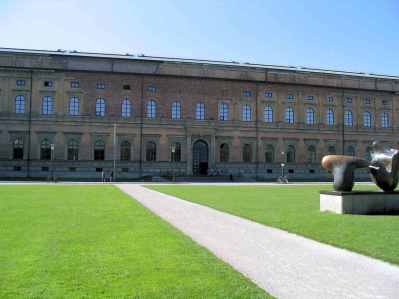
|
I spent a good two hours walking around the Alte Pinakothek (Old Picture Gallery), which
was commissioned by King Ludwig I and built between 1826 and 1836.
It contains one of the best collection of the painter Peter Paul Rubens in the world.
The Old Pinakothek is across the street from the New Pinakothek. This collection has
lots of religious art, which I don't particularly care for.
I didn't capture the artist's name nor the name of some of the paintings - you will
just have to visit and see for yourself. Damaged during World War II, the Alte
Pinakothek had to be rebuilt.
|
|
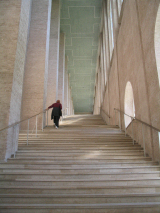
Let's ascend to the main galleries ...
|
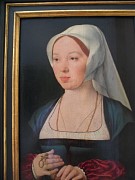
Joos van Cleve the Elder
Portrait of a Woman 1540
I liked the headdress and I liked the expression on the subject of this painting.
I wonder if the people who commissioned this painting thought it was a good likeness.
|
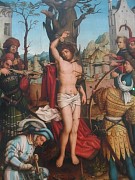
Hans Holbein the Elder (1465 - 1524)
St. Sebastian Altar; Central panel: Martyrdom of St. Sebastian 1516
He and his brother Sigismund Holbein painted religious works in the late
Gothic style. Hans the Elder was a pioneer and leader in the transformation of
German art from the Gothic to the Renaissance style.
Sebastian, bodyguard of the Emperor Diocletian and a Christian, regularly
stood by martyrs at the time of their death. He was consequently himself
sentenced to death by the Emperor. As he survived his death by arrows,
he was beaten to death and thrown into the sewers of Rome.
|
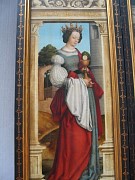
St. Barbara is one of the Fourteen Holy Helpers (also known as Helpers in Need).
Her association with lightning has caused her to be invoked against lightning and
fire; by association, she is also the patron of artillery and mining. Her feast
is celebrated on December 4 in the Tridentine use of the Roman Catholic Liturgy;
in the 1969 reformed Roman Catholic liturgical calendar her public cultus was
suppressed to a purely local celebration, and her name was dropped from the litany of saints.
Orthodox Christians have never ceased to venerate St. Barbara, among whom she remains very popular.
If you enlarge this picture look at the beauty of the deepness of the color and the
amount of detail in the dress.
|
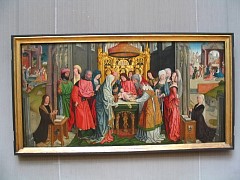
Der Heiligen Sippe (1450 - 1510)
Die Beschneidung Christi
This translates as "The curtailment of Christ". Not a clue here. I hope this
isn't about circumcision .... I was drawn by the pretty contrasting colors.
Enlarge this and check out the other groups of people off to the left and right.
|
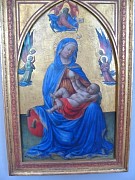
Masolino da Panicale (1383 - 1447)
Virgin and Child Ca. 1435
The blue and the gold are a pretty combination, I wonder why the artist saw fit to
include the naked breast? I would think in 1435 this would be riske, even with
a baby present. On the other hand, maybe everyone then related to breast feeding,
there being no bottles, etc. - it was mom or a wet nurse.
|
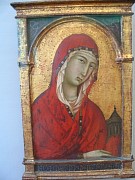
Segna Di Buonaventura (active by 1298, died 1327)
Saint Magdalena
This picture of a forlorn Magdalena was made more than one hundred
years earlier than the works above. The face is not realistic, yet there
is some human-ness to it. Again, only the paintings of this era that use
contrasting pretty colors seemed to appeal to me.
|
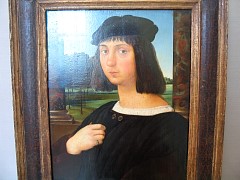
Umbrisch
Portrait of a young man.
From the Early Renaissance I like the middle ages haircut and the marble columns
on either side of this gentleman.
|
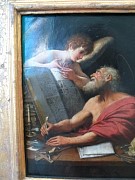
Bolognese (17th Century)
St. Heirnonymus
Saint Jerome (ca. 347 - September 30, 420
Latin: Eusebius Sophronius Hieronymus) is best known as the translator of the
Bible from Greek and Hebrew into Latin. He also was a Christian apologist.
Jerome's edition of the Bible, the Vulgate, is still an important text of
the Roman Catholic Church. He is recognized by the Roman Catholic Church
as a canonized Saint and Doctor of the Church. Here I imagine an angel
is helping him with his spelling.
|
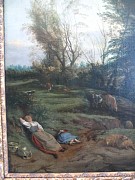
Jan Siberechts (1627 - 1703)
Viehweide Mit Schlafender Frau 1660
Livestock grazing with sleeping woman
This is the Baroque style of painting done by a Flemish landscape painter.
Why is the jug overturned?
|
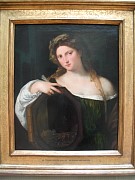
Tiziano Vecellio (1477-1576)
Profane Love (Vanity) c. 1515
This painter is also known simply as Titian. The subject of the painting holds a mirror
that reflects her worldly possessions, which, along with her appearance, show
her vanity.
This allegorical painting is an early Titian work, which was later
subjected to several changes probably from the master himself: in
the once empty mirror, coins, jewelry and an old woman with distaff
were added; additionally, an extinguished candle was placed in the
hand of the main figure. The fleeting nature of all things earthly
was enhanced through these alterations.
|
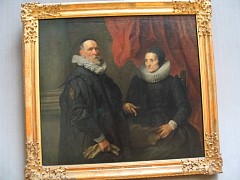
Anthonis van Dyck (1599 - 1641)
Jan de Wael und seine Frau Gertrude de Jode
Van Dyck painted a great many portraits - for the last ten years of his
life he lived and painted mainly in London as a Court portraitist.
I found this portrait of an elderly couple sad - she isn't looking at him,
he isn't looking at her. Now their locked in this condition forever.
|
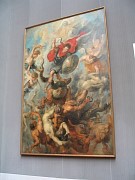
Peter Paul Rubens
Angel's fall
This art gallery exhibits the largest collection of Ruben's work anywhere.
Rubens was a prolific seventeenth-century Flemish and European painter, and
a proponent of an exuberant Baroque style that emphasized movement, color,
and sensuality. He is well-known for his Counter-Reformation altarpieces,
portraits, landscapes, and history paintings of mythological and allegorical
subjects. This painting is most likely Saint Michael and his angels casting
Satan out of Heaven. These paintings are huge ...
|
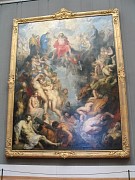
Peter Paul Rubens (1577 - 1640)
The Great Last Judgment 1617
Christ appears to judge humankind at the time of the Last Judgment.
The tombs are open, the dead have arisen and
await their separation into those who are blessed and those who are damned
(Mat. 24 and 25). This painting was commissioned by Duke Wolfgang Wilhelm of
Pfalz-Neuburg for the high altar of the Jesuit church in Neuburg an der Donau;
the nudity it contains met with general disapproval. As a result the painting
remained in its church location - sometimes covered - for only a few decades.
In 1692 it was removed to the Düsseldorf Gallery.
|
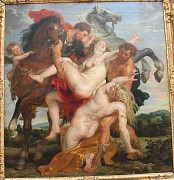
Peter Paul Rubens (1577 - 1640)
The Rape of the Daughters of Leucippus 1617/18
As many of his paintings feature full-figured, voluptuous women, the word "Rubenesque"
(meaning plump or fleshy, yet not "fat," and used exclusively to describe women)
is derived from his last name.
The names Castor and Pollux are used to refer to the two stars in the constellation
Gemini, the Twins.
Helen of Troy, so famous afterwards
as the cause of the Trojan war, was their sister.
Castor and Pollux , the sons of the god Zeus, abducted and
later married Hilaera and
Phoebe shortly before their weddings.
A reference to marriage may be at play here.
Some view Rubens's painting as issuing from a tradition that
emerged among princely patrons at the time, of incorporating large-scale
mythological rape scenes into their palace decorations.
|
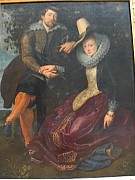
Peter Paul Rubens (1577 - 1640)
Rubens and Isabella Brant in the Honeysuckle Bower C. 1609
Even though the photo I took is out of focus, I include this portrait of Rubens and the
woman who became his wife. In contrast to the older couple above, I think this
is the way every couple would want to be remembered. Check out the hat, collar,
and bodice worn by Isabella - how long would it take a woman to get into this attire?
This snapshot-like scene in which middle-class contentedness,
substantial affluence and strong affection are expressed broke new ground
in portrait painting.
Rubens did
not however give up using traditional symbolism: Honeysuckle was a well
known symbol for faithfulness and hands laid over one another ("dextrarum iunctio")
have symbolized matrimony since ancient times.
|
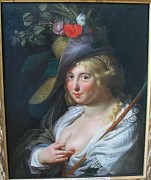
Paulus Moreelse (1571-1638)
The Blonde Shepherdess
Moreelse was a Dutch Baroque era painter. I think I can speak for all
men when I say when we think of early 17th century shepherdesses, this is what we picture.
I like the hat, but wonder how the sitting for this picture was done. Did this poor
woman have to sit like this for hours and hours, or was a sketch done first and then
the painting created? There are a lot of pictures with this particular pose, yet it always
surprises me. There is a famous painting in the Louvre like this, where the pose with the
nipples is supposed to symbolize pregnancy. After this picture was put on display, I wonder
how many young men went out into the countryside looking for shepherdesses ...
|
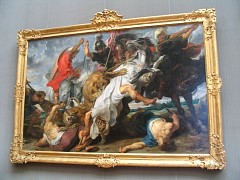
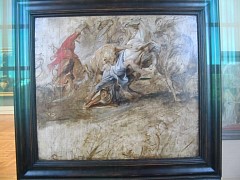
Peter Paul Rubens (1577 - 1640)
Lion Hunt Ca. 1621
... and the sketch used to make the Lion Hunt
Rubens characterized this painting as incorporation both "Grace and violence".
|
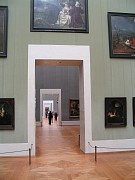
This gives you the feeling of what it's like to wander through the gallery.
|
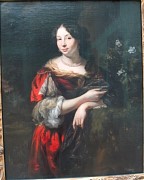
unknown to me
I didn't successfully record who painted this or who it's of. I like the contrast of the
complexion and the dark background, the facial expression and the color supplied by the dress
which matches her lips.
|
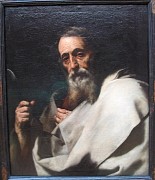
Jusepe de Ribera (1591 - 1652)
St Bartholomew (?)
Ribera was a leading painter of the Spanish school, although
his mature work was all done in Italy.
His early works were gloomy and startling. Before
the 1630s his style was strong contrasts of dark and light, as seen here.
I like the detail and realism of the face and hands.
|
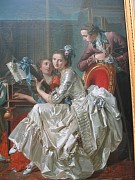
Louis Rolland Trinquesse (ca.1745 - 1800)
Gallant Society
The detail of the silk dress caught my eye, along with the gold detail in the
young man's jacket. I wonder which young lady this guy is hitting on ...
|
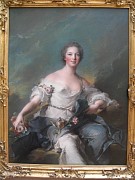
Jean-Marc Nattier (1685 - 1766)
The Marquise de Baglion as Flora 1746
Nattier was a French Rococo era painter.
The financial collapse of 1720 all but ruined Nattier,
who found himself forced to devote his whole energy to portraiture.
He became the painter of the artificial ladies of Louis XV's court.
He tended to add
classical Greek and Roman elements to his sitters, a style that
was popular until the 1740’s when a more realistic approach was preferred.
I find the eyes of this woman appealing. Continuing our "where are the hands"
conversation, they are lightly clutching a rose (left) and the folds of her
dress (right).
|
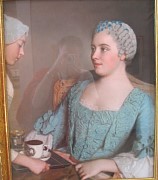
Jean Étienne Liotard (1702 - 1789)
The Breakfast
(with the photographer's reflected image)
In his later life Liotard traveled
throughout Europe painting portraits in pastels.
He gained an international reputation in this medium
for his care and skill in achieving an accurate likeness
of his sitters. At the age of seventy-nine, he published
a treatise on the principles of painting, in which he
explained his belief that painting is and should be a mirror of nature.
Continuing the mirror theme, c'est moi.
|
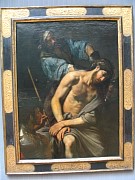
Valentin de Boulogne (1591-1632)
Crowning with Thorns
Notwithstanding the religious nature of many of his works, the subject of
a share of Valentin's body of work is
a type of composition invented by Caravaggio
where fortune tellers, drinkers, or gamblers are grouped around a table.
Valentin himself was fond of carousing and fine wine,
he lived and died in the self-indulgent world he sometimes painted
I didn't include many paintings with religious themes: there are a great
many here in the collection of the Old Pinakothek art gallery.
|
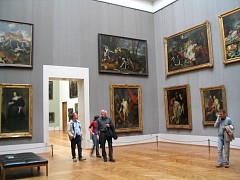
Again, this photograph gives a good idea of what it's like to wander through the Old Pinakothek.
|